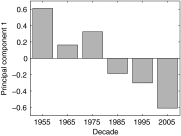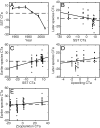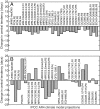Climate change and decadal shifts in the phenology of larval fishes in the California Current ecosystem
- PMID: 26159416
- PMCID: PMC4522805
- DOI: 10.1073/pnas.1421946112
Climate change and decadal shifts in the phenology of larval fishes in the California Current ecosystem
Abstract
Climate change has prompted an earlier arrival of spring in numerous ecosystems. It is uncertain whether such changes are occurring in Eastern Boundary Current Upwelling ecosystems, because these regions are subject to natural decadal climate variability, and regional climate models predict seasonal delays in upwelling. To answer this question, the phenology of 43 species of larval fishes was investigated between 1951 and 2008 off southern California. Ordination of the fish community showed earlier phenological progression in more recent years. Thirty-nine percent of seasonal peaks in larval abundance occurred earlier in the year, whereas 18% were delayed. The species whose phenology became earlier were characterized by an offshore, pelagic distribution, whereas species with delayed phenology were more likely to reside in coastal, demersal habitats. Phenological changes were more closely associated with a trend toward earlier warming of surface waters rather than decadal climate cycles, such as the Pacific Decadal Oscillation and North Pacific Gyre Oscillation. Species with long-term advances and delays in phenology reacted similarly to warming at the interannual time scale as demonstrated by responses to the El Niño Southern Oscillation. The trend toward earlier spawning was correlated with changes in sea surface temperature (SST) and mesozooplankton displacement volume, but not coastal upwelling. SST and upwelling were correlated with delays in fish phenology. For species with 20th century advances in phenology, future projections indicate that current trends will continue unabated. The fate of species with delayed phenology is less clear due to differences between Intergovernmental Panel on Climate Change models in projected upwelling trends.
Keywords: California Current; fish larvae; global change biology; phenology; upwelling ecosystem.
Conflict of interest statement
The author declares no conflict of interest.
Figures









References
-
- Parmesan C, Yohe G. A globally coherent fingerprint of climate change impacts across natural systems. Nature. 2003;421(6918):37–42. - PubMed
-
- Root TL, et al. Fingerprints of global warming on wild animals and plants. Nature. 2003;421(6918):57–60. - PubMed
-
- Menzel A, et al. European phenological response to climate change matches the warming pattern. Glob Change Biol. 2006;12(10):1969–1976.
-
- Parmesan C. Influences of species, latitudes and methodologies on estimates of phenological response to global warming. Glob Change Biol. 2007;13(9):1860–1872.
-
- Poloczanska ES, et al. Global imprint of climate change on marine life. Nature Clim Change. 2013;3:919–925.
Publication types
MeSH terms
LinkOut - more resources
Full Text Sources
Other Literature Sources
Medical

